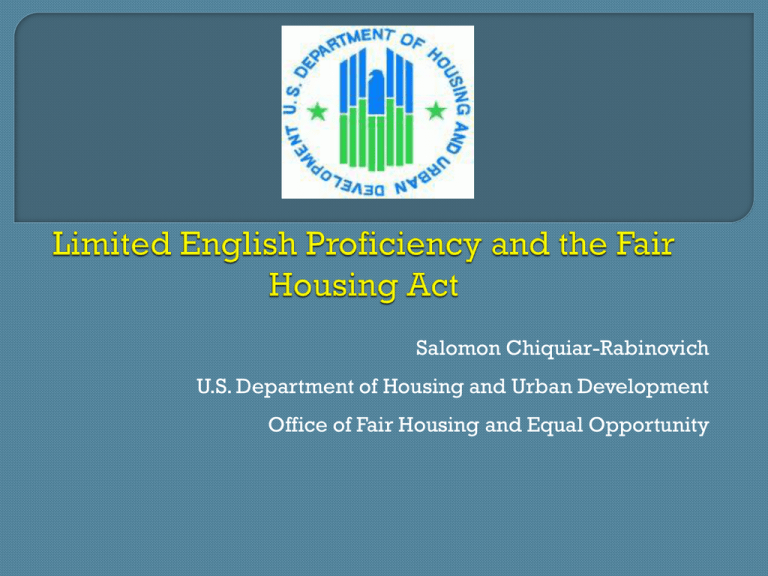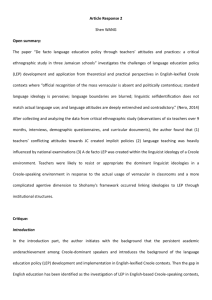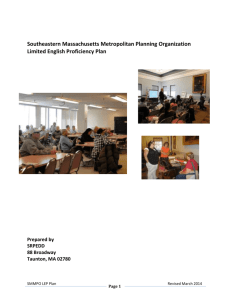
Salomon Chiquiar-Rabinovich
U.S. Department of Housing and Urban Development
Office of Fair Housing and Equal Opportunity
Census
Bureau defines Limited English
Proficiency as speaking English “less
than very well”
From 1990 to 2010 the LEP population
grew by
• 57% in MA – 348,000 to 547 thousand
• 80% in the USA – 14 million to 25.2 million
8.8%
of MA’s population is LEP,
slightly above national average.
THE INDIVIDUAL WITH LEP?
OR THE HUD RECIPIENT?
Provides
4 factors to assess needs of LEP
persons:
1. The number or proportion of LEP persons
served or encountered in the eligible service
area
2. Frequency with which LEP individuals come
into contact with program
3. The nature and importance of the program,
activity, or service provided by the program
4. The resources available to the recipient
Fair Housing Act makes it unlawful to discriminate
because of race, color, religion, national origin, sex,
disability, and familial status in the sale, rental, or
advertising of housing
Discrimination against persons who are Limited
English Proficient can violate the Fair Housing Act
when LEP is a result of a person’s national origin.
Injunctive
relief
Damages for victim
Policy/practice changes
Relief to protect the public interest
Potentially, identification of additional
victims via complaints or victims fund
relief
Direct
Evidence
Disparate Treatment
Disparate Impact
Facially discriminatory policy that explicitly treats
non-English speakers differently because of their
national origin
To violate the Fair Housing Act, direct evidence must
reference the national origin of the person, not just
the fact that they do not speak English well or at all.
EXAMPLE:
A landlord telling a Mexican family, “I do not rent to
Mexicans because they can barely speak English”
OR “I don’t rent to people who speak Russian.”
Housing provider
treats LEP persons
differently than
persons who speak
English well, or
housing provider treats
LEP persons from
certain national origins
differently than LEP
persons from other
national origins.
EXAMPLE:
• Applicant who speaks English less well or not
at all applies for apartment. Testing shows
that only those applicants who are LEP are
selected for credit checks or background
checks
Facially
neutral policy, consistently applied,
has a disparate impact on a protected class
Intent to discriminate based on national
origin is relevant but not required.
Often
arises where housing provider has an
“English Only” policy
• Even when consistently applied, persons from non-
English speaking national origins may be
disproportionately affected by these policies, as they
comprise the overwhelming majority of persons who
cannot speak English well or at all.
Recognizing Housing Discrimination
Title VIII of the Civil Rights Act of 1968 (The Fair Housing
Act) prohibits discrimination in housing on the basis of
race, color, religion, sex and/or national origin.
Five steps:
• Identify the specific policy or policies that are
•
•
•
•
allegedly discriminatory (“Must speak English”)
Determine whether the policy was consistently
applied (if not, see unequal treatment)
Examine the impact of the policy based on national
origin using statistics for the particular group (May
aggregate groups—e.g. impact in community on
Spanish speakers)
If a disparate impact is found, identify the landlord’s
reasons for the policy – are they real and supported
by a substantial business justification?
If a substantial business justification exists, is there a
less discriminatory alternative?
EXAMPLE:
• Applicants are told that they must speak and read
English to apply. Policy is consistently applied. In
area, disproportionate impact is on Russian
speakers.
• Justification is the need for prompt communication
between tenant and landlord in case of emergency
• Less discriminatory alternatives might include use of
Language Line for communication OR designation of
English speaker as intermediary for communication
HUD
LEP Guidance issued in 2007 pursuant
to Executive Order and Title VI applies to
recipients of federal financial assistance
Provides 4 factors to assess needs of LEP
persons:
• The number or proportion of LEP persons served or
encountered in the eligible service area
• Frequency with which LEP individuals come into
contact with program
• The nature and importance of the program, activity,
or service provided by the program
• The resources available to the recipient
Number
or proportion of LEP persons
served or encountered by eligible
service area
• To determine, consider only LEP persons and not
all persons from non-English speaking national
origins
Complaint
investigations initiated by
conversation or letter
Compliance reviews
• Limited compliance review focuses on LEP
issues only
• Broader compliance review may focus on
race/national origin discrimination issues
including LEP
Letter of Determination
Damages for victims
Remedial
authority through a Voluntary
Compliance Agreement
Ultimately non compliance can adversely
affect funding
• NOFA funds (General Section of the NOFA) for future
funds
• Funding suspension or termination for non
compliance
Contact me at :
Salomon Chiquiar-Rabinovich
U.S. Department of Housing and Urban Development
Office of Fair Housing and Equal Opportunity
Thomas P. O'Neil Federal Building
10 Causeway Street--Room 321
Boston, MA 02222-1092
Tel: 617-994-8310 (Dir)
Fax: 617-565-7313
Salomon.Chiquiar-Rabinovich@hud.gov












